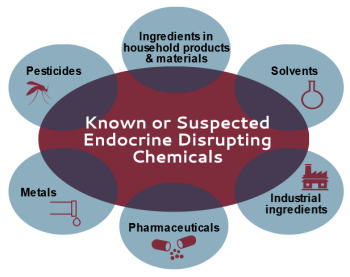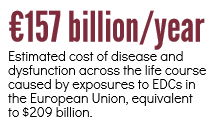“Endocrine disruptors are chemicals that may interfere with the body’s endocrine system and produce adverse developmental, reproductive, neurological, and immune effects in both humans and wildlife. A wide range of substances, both natural and man-made, are thought to cause endocrine disruption, including pharmaceuticals, dioxin and dioxin-like compounds, polychlorinated biphenyls, DDT and other pesticides, and plasticizers such as bisphenol A. Endocrine disruptors may be found in many everyday products– including plastic bottles, metal food cans, detergents, flame retardants, food, toys, cosmetics, and pesticides."
1 Endocrine Disruptors
As demonstrated by the NIEHS statement, products used in our daily lives, chemicals circulating in our environment, and some occupational exposures can alter endocrine function. Endocrine disrupting chemicals (EDCs) can alter the hormonal signals that control and guide much of our growth and development, the way our organs function, and our ability to fight disease.
Types of Endocrine Disruptors
- Natural hormones released into the environment from an animal and chemicals produced by one species that exert hormonal actions on other animals. For example, human hormones unintentionally reactivated during the processing of human waste in sewage effluent may result in changes to fish.
- Natural chemicals including toxins produced by components of plants (the so-called phytoestrogens, such as genistein or coumestrol) and certain fungi.
- Synthetically produced pharmaceuticals that are intended to be highly hormonally active. Examples include the contraceptive pill and treatments for hormone-responsive cancers. These may also be detected in sewage effluent.
- Man-made chemicals and by-products released into the environment. Laboratory experiments have suggested that some man-made chemicals might be able to cause endocrine changes. These include some pesticides (including DDT and other chlorinated compounds), chemicals in some consumer and medical products (such as some plastic additives), and a number of industrial chemicals including polychlorinated biphenyls (PCBs) and dioxins).

EDC Mechanisms
Research on endocrine disruptors comes primarily from animal studies where researchers can investigate the mechanisms through which endocrine disruptors alter the endocrine system and hormonal changes.2
Some chemicals can act on the endocrine system to disturb the homeostatic mechanisms of the body or to initiate processes at abnormal times in the life cycle. The chemicals can exert their effects through a number of different mechanisms:
- They may mimic the biological activity of a hormone by binding to a cellular receptor, leading to an unwarranted response by initiating the cell's normal response to a naturally occurring hormone at the wrong time or to an excessive extent (agonistic effect).
- They may bind to the receptor but not activate it. Instead the presence of the chemical on the receptor will prevent binding of the natural hormone (antagonistic effect).
- They may bind to transport proteins in the blood, thus altering the amounts of natural hormones in circulation.
- They may interfere with the metabolic processes in the body, affecting the synthesis or breakdown rates of the natural hormones.
Endocrine disturbances in the human body result in breast cancer, testicular cancer, disruption of thyroid and ovary function, Alzheimer's disease, schizophrenia, nerve damage, and obesity.4 as well as lowered fertility, increased incidence of endometriosis, and other types of cancer. Exposures to endocrine disruptors during pregnancy and soon after birth may pose the greatest risk to long-term health.5
Some EDCs and Specific Health Outcomes
Research from The National Toxicology Program (NTP), a division of the Department of Health and Human Services, as well as other researchers and NIEHS have reported significant effects of endocrine disruptors.
Increased Risk of Disease from Prenatal DES Exposure6 |
|
| Preterm delivery | 4.7 times higher |
| Clear-cell adenocarcinoma | 40 times higher |
| Neonatal death | 8 times higher |
| Loss in second trimester pregnancy | 3.8 times higher |
| Ectopic pregnancy | 3.7 times higher |
| Stillbirth | 2.4 times higher |
| Infertility | 2.4 times higher |
| Early menopause | 2.4 times higher |
| Breast cancer | 1.8 times higher |
| The reproductive health issues listed here are described further on our Reproductive Health Research and Resources webpage. | |
Diethylstilbestrol (DES) is a synthetic estrogen created in 1938; from the 1940s through the 1970s it was added to livestock feed to enhance muscle growth7 and prescribed for the prevention of miscarriages. The medical community discontinued its use after a 1971 article in the New England Journal of Medicine reported an association between fetal exposure during the first trimester of pregnancy and a rare cancer (vaginal adenocarcinoma) that manifested decades later in adolescents and young women who were exposed in utero. These DES daughters experience higher rates several diseases and disorders highlighted in the list at right.8 DES sons have an increased risk for non-cancerous epididymal cysts (growths on the testicles).9 Although DES was discontinued as a prescribed medication in 1971, it was used as a feed additive in cattle until 1979.10
Other Examples of EDCs
![]() These toxicants are discussed in more detail on their respective webpages on this site.
These toxicants are discussed in more detail on their respective webpages on this site.
- Organochlorines such as dioxins and perchlorate can disrupt thyroid function.11
- The dioxin TCDD is a known carcinogen,12 and the European Union prioritization list classifies TCDD as an endocrine disrupting chemical.
- Specific PCBs, such as aroclor, have been listed as a “probable carcinogen” by the IARC13 and US EPA14 The EU Prioritization List15 shows aroclor to be an endocrine disruptor, and the State of California’s Proposition 65 lists cancer and developmental toxicity as disease endpoints16
- Phthalates, BPA, and other packaging chemicals can cause reproductive disease.17 Di(2-ethylhexyl) phthalate (DEHP) is a high production volume chemical. The NTP found that DEHP may pose a risk to human development, especially critically ill male infants.18 Regarding BPA, the NTP concluded there is “some concern for effects on the brain, behavior, and prostate gland in fetuses, infants, and children at current human exposures to bisphenol A.19
- Polybrominated diphenyl ethers (PBDEs) are known to cause numerous problems including cancer, thyroid problems, and neurodevelopmental effects. Several of the brominated flame retardants have been banned in the EU and US.
- Insecticides such as toxaphene and DDT have carcinogenic properties.20
Disease and Economic Burden of EDCs
|
from Trasande et al. 201521 |
In 2015, an expert panel in the European Union came to consensus on the disease and economic burden resulting from EDC exposure. Using new methods, they were able to assess the probability of causation for EDC exposures and disease outcomes and then quantify the cost to society for the resulting disease burden. Expert panels achieved consensus at least for probable (>20%) EDC causation for IQ loss and intellectual disabilities, autism, ADHD, childhood and adult obesity, adult diabetes, male genital tract malformations, male infertility, and disorders associated with testosterone signaling. They estimated these disease endpoints cost the EU €157 billion, 1.23% of the gross domestic product, equivalent to $209 billion US dollars, annually.22
See more about EDCs and health in the list of CHE publications and Dig Deeper resources in the right sidebar.
This page's content was created by Lorelei Walker, PhD, and Nancy Hepp and last revised in August 2016. Content from Toxipedia is noted with the logo.
CHE invites our partners to submit corrections and clarifications to this page. Please include links to research to support your submissions through the comment form on our Contact page.
* header image used with permission of Sarah Mosko

